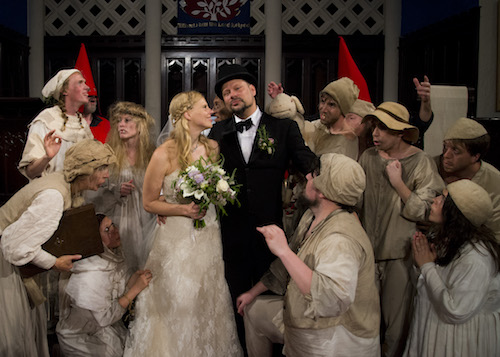
Surrounded by her mother, two bridesmaids, a flower girl, and long-time boss and friend who would walk her down the aisle, Megan Bones was especially nervous. She waited in the church’s community room, applying lipstick intermittently while raindrops pattered against the stained glass windows.

Unlike most brides, Megan Bones did not practice or even plan this moment. It was left in the hands of Dzieci Theatre Company, who for months labored over scripts and rehearsals for the first ever Fools Wedding. No one, not the bride, groom, audience members or even some of the theatre group, knew what to expect. It was not a traditional wedding and the Fools were not everyday wedding planners.
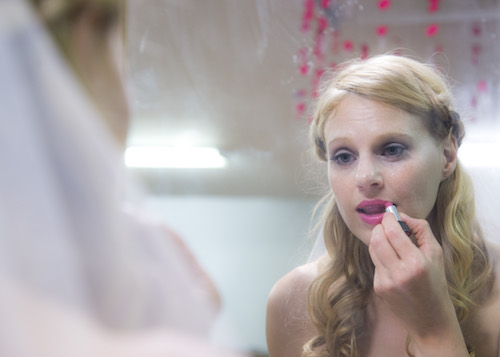
Dzieci (djyeh-chee) is the Polish word for children. Since 1997, The Dzieci Theatre Company’s mission has been to use theatre as a vehicle for holistic self-development and public service work. The founder, Matt Mitler, who is still head of the group after 19 years, described the group’s philosophy as encouraging “development on a physical and emotional level but also development on a spiritual and psychological level.” Their philosophy is that they don’t perform for the ego. “We find a way to approach performance for the public as service work. So the work we might do with someone dying in a hospital bed would not be any different than what we would do in the theatre, or at a wedding.” This was their first time trying it as a wedding performance.
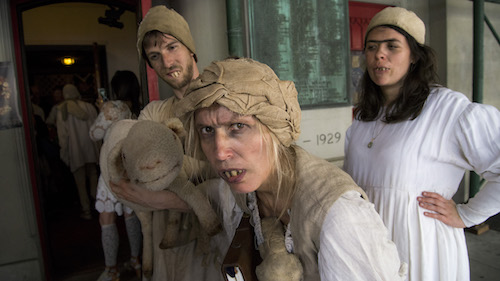
Fools Wedding was open to the public, and I wondered what the New York City passersby must have thought. Strangers wandered in off the streets, attracted by the noise and the two Fools posted out front, ghoulishly waving folks inside. While the wedding guests arrived, the Dzieci Theatre Fools darted around the Church. Their tattered, dirty gowns—layers of ripped fabric, white, off-white, beige, and brown—flowed behind them like the trailing capes of passing ghosts. One Fool thrust programs at audience members: friends, family, acquaintances, and those strangers who had accepted the public invitations. I took a program and tried to thank him, but he just grunted and scurried off to hand out more.
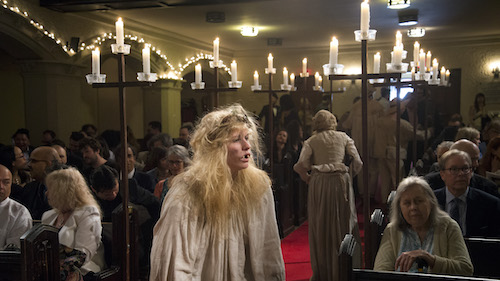
I am both a friend and an outsider, and I had never seen the Fools perform so I was excited. I was attending with my aunt. When we walked in, a Fool asked us if we were friends or family. The first two pews were reserved for family. My aunt tried to say no, but I interrupted her. “Yes, we’re family,” I said—the bride was my mother’s second cousin’s dance instructor some twenty years ago and has remained a dear friend—and I shamelessly slid into the second pew. I wanted a front row seat.
At the beginning of the ceremony, one Fool, Su Hendrickson, was leaning over the marble baptismal font, her head buried in the bowl that holds the holy water.
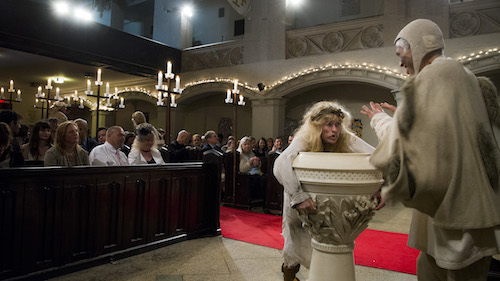
Another wandered up and down the aisles aimlessly, exhaling a sort of hokey whine. Some gathered around the altar along with the groom who patiently awaited his bride, while others ushered guests to the pews, communicating with moans or grunts. The Fools were tenacious but for the most part, silent. They lead guests to the right place by tugging at their clothing, or using their expressions, alight with insistence. If that didn’t work, a forceful point in the right direction did the trick. Guests were surprised by the gnarled and yellowed teeth, many blackened along the gum-line. Some were aghast at the tattered attire; it was unlike any they’d seen at a wedding, much less one taking place on the Upper West Side of Manhattan. I was titillated by the strangeness of finding myself in such marvelously obscene company.
The groom was at the front of the church. He shifted from one foot to another, awaiting his bride. He wore a classically cut black tuxedo complete with a black bow tie, top hat, and a boutonniere pinned to his breast. But instead of standing beside his groomsmen like most grooms, Troy Hahn had Ugo, a man wearing a white robe blackened with soot and a rough-hewn linen robe that looked like it was straight out of Game of Thrones.
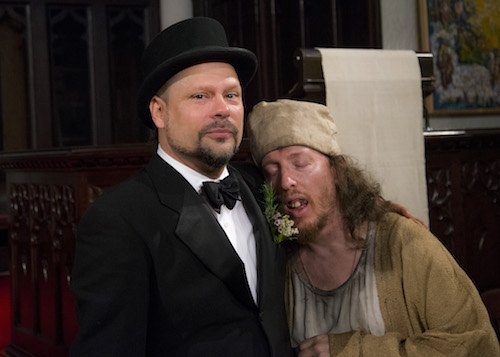
Clutching Troy’s hand, Ugo was like a cautious but precocious child. He would be affixed to Troy’s side throughout the entire ceremony.
I glimpsed some of the other VIP guests distinguished with a small hunk of fool’s gold hanging on a piece of hemp around their necks. The Fools tried to lead them to the first two pews, both of which were mostly empty despite how crowded the church had become, but the guests slunk back, shaking their heads and wearing expressions of horror. They decidedly did not want to be that close.
“Grruf!” one Fool barked. “Ugh!” another chimed in. Together, the two Fools yanked one of the reluctant men’s shirt sleeve, a crisp blue button-up cuffed at the ends and speckled dark blue from the rain outside. The man sunk into a seat in the front row, disgruntled but too surprised to dispute. He instead inspected his cuff for grime.
Wavering between suspicion and a kind of cagey delight, guests fidgeted in their seats. Recent arrivals lingered in the back, selecting pews a safe distance from the excitement. And I couldn’t wait. The procession was about to begin, and a Fool at the front was screaming for the bride. “We cannot have a wedding without a bride!” he yelled. His call echoed through the church’s lofted atrium. When Megan did not turn up, an argument ensued among the Fools.
“I shall be the bride!” one Fool, Sanceline said.
Troy looked bewildered.
Which one of them would take her place?
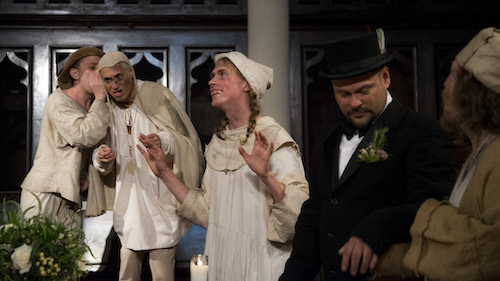
Sanceline was blonde and her hair hung in knotted trails down the front of her shoulders as she warbled in circles around Troy. Another Fool took the Holy Water and began washing Sanceline’s hands, preparing her for matrimony. They frolicked.
Troy was laughing but his laughter was muddled with dismay. This might not have been what he had in mind when he suggested he and Megan get married this way.
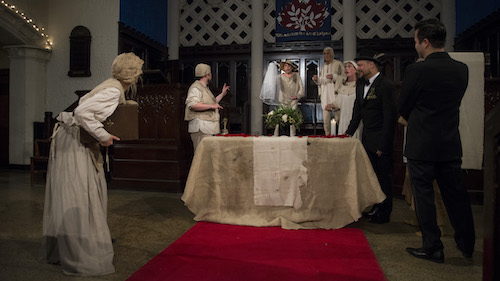
“No!” An older Fool—a woman, played by Yvonne Brecht, looking a touch wiser than the others with a giant book in her grasp—yelled at the two children. Then, after a snap moment, she slammed the book over top the head of the Fool who had been frolicking with Sanceline.
“Megan! Bride!” She screamed.
There was chaos among the Fools and collective discomfort in the crowd. The Dzieci Theatre Fools are used to this particular discomfort from their audiences. They cultivate it.
For years, The Dzieci Theatre has visited hospitals, schools, and put on performances in the street. The actors are both active and receptive, often improvising. At various venues, including a children’s detention center, a mental hospital, and a home for the terminally ill, audience members affect the performance. “Audiences come in out of the rain, the cold, or the heat, and each will evoke a different response from us,” Mitler said. There are also those that want nothing to do with the performers, or, occasionally, who are passionately adverse. “We’ve played with people who say, ‘get out of here!’” Mitler said.
“We still work with that.”
Megan Bones has been with the company for over ten years. She described their performances as whatever is needed in that moment. “We might sing in their language if we know a song. Maybe just sit there and listen to them, too. I’ve taken a foot and put it on my vocal chords so that the vibration is going there,” Megan said. If someone in a hospital room is in a coma then the actors will get as simple as possible, performing some hymns or choral work. If that same patient has a group of visiting family members who are dancing, seemingly open to the group’s presence, then the actors will become more lively, standing and dancing around the room. It’s up to the audience how much they want to be exposed to such vulnerabilities.
Fools Wedding is based on Dzieci Theatre’s most popular performance, one they’ve been doing for almost as long as the group’s existence: Fools Mass. During Fools Mass, a group of village idiots is forced to enact its own mass, due to an untimely death of its beloved pastor. They perform hymns and chants from the 8th to the 14th century, encouraging audience participation and holding nothing back. The piece, much like Fools Wedding, is a collaboration of the absurd, the comedic, but also the raw and emotional. Over the years, it’s had audience members laughing until they cry, crying intermittently, and even a few who have stormed out, brimming with anger.
It all began as an investigative art piece. During an adaptation of Aldous Huxley’s The Devils of Loudon, which takes place in 1600’s France, the actors were learning Gregorian songs from that era when Mitler realized that in order to understand how the music would work, they needed to get simpler, and even simpler. They needed to be able to look at the piece with the simplistic approach of a child.
Using the Catholic Mass, Mitler took the company in the characters of children. “I felt the only way to really approach the mass and find out what in it could teach me was to approach it from a kind of place of innocence and naivety and that’s how the village idiots came about. Then we set it in the plague years and basically subbed the actual structure of a mass, filled it in with songs that we were working on, and started developing these characters,” Matt said.
The Fools’s attire, designed by costume designer, Karen Hatt, was based on paintings by Peter Bruegel. Bruegel (or Brueghel) is a sixteenth century Netherlandish Renaissance painter known as Peiter the Elder and renowned for his paintings of landscapes and peasants. Megan’s Fool was based on Bruegel’s Mad Meg, a fantastical religious oil painting of an elderly woman armed with a sword, cutlery, and a moneybox. Her demeanor is what Megan aims to capture when she’s on stage, and it is one of impassioned madness.
But at Fools Wedding, Megan was not Mad Meg, she was herself. When Troy, who is not a member of the group, suggested that they have the Fools marry them, Megan was both exhilarated and surprised. She asked, “Do you know what you’re getting yourself into?”
A half an hour into the procession, there was still chaos. And no bride. In the midst of it—Fools arguing about who would be the bride, Ugo still clutching Troy’s hand who no doubt ached for his real bride, Fools danced and skipped around the church, some singing, the audience collectively holding their breath—a sudden note resounded.
From the back of the church, the doors opened, and in walked the flower girl, clutching the hand of the Fool who had her head overturned in the baptismal font before the procession began. Two bridesmaids followed closely. Behind them all: Megan. Her lipstick, a pale pink, brought out the light brown freckles that could be glimpsed beneath her veil. Her blond hair fell in waves across her shoulders. The bodice of her white, lace-covered gown, was an a-line cut that made her look not just like a princess but also clean and pristine beside the dirty Fools.

Megan’s boss, owner of New York’s speakeasy, The Back Room, was by her side. The audience stood, and sighed in unison. The bride had finally appeared, and the familiar, traditional elements of a wedding procession were seemingly in their appropriate place. People were comfortable again. But not for long.
The dirty, soot-covered ordained minister—Matt Mitler in his full Fool form—rushed toward Megan, screaming, “no, no, no, sorry, sorry, sorry!”
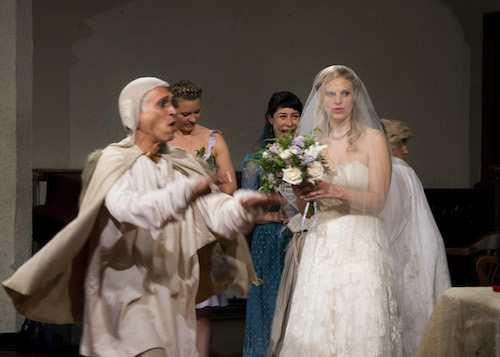
He shooed her and her troop back up the aisle and out the doors, screaming, “Wrong song!” at them. “Sorry, sorry!” The audience was confused. Some laughed. This all happened three more times. Audience members looked toward each other, dubious: why would two people choose to play out what so many call ‘the most important day of your life’ like this?
According to Ryan Castalia, a member of the cast, it is often easier to embody his Fool than his own identity. “When I’m performing Fools Mass or Fools Wedding,” Ryan said, “I feel more comfortable in myself than I do in my day-to-day.”
“That’s what the Fools do,” Megan explained. “There’s a raw discomfort in the performances that creates a gulf between the actors and the performers.”
By slowing down their movements, leveraging an element of surprise and strangeness, the Fools foster this discomfort. And within it, magic happens. They break through an invisible barrier. They bring with them a feeling of silliness, intimacy, and truth. For one small moment, if audiences will allow it, they are able to embody buffoonery. There are no expectations. There’s no pressure. Nobody telling them to be a certain way, to maintain a certain ‘demeanor,’ and this is Dzieci Theatre’s philosophy. But this only happens when audiences welcome the oddity of it all. With acceptance, comes something magical.
“We don’t cross the gulf.” Matt explained, “The audience crosses the gulf. The patients in the hospital cross the gulf.” Matt, Ryan, and Megan agreed that at the beginning of most of their performances, audiences are repelled by them. Some even stand up and walk out, their discomfort too strong to handle. But for those who have stayed, who have chosen not just to endure, but to accept it, something has changed. The Dzieci Theatre fools have won them over.
“They’re lining up to get selfies with their favorite Fool,” Matt said. “People are often hugging us and crying and thanking us but we haven’t changed, they’ve changed.”
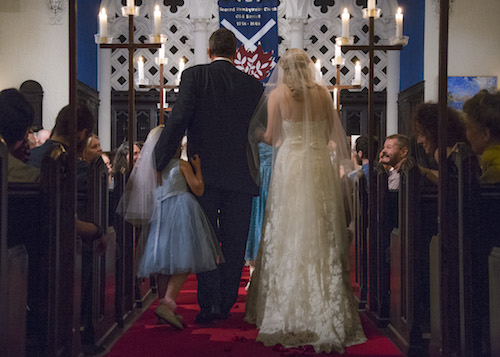
When the minister announced that he needed twenty or so members from the audience to help with an animal sacrifice, there was a pause in the room.
A Fool came down the aisle with a stuffed, but lively looking lamb. Many in the crowd were astonished and confused. Some jovially booed. “Save the lamb!” rippled through the crowd. The lamb, the minister announced, would be spared.
“Yes,” agreed a Fool. “Human sacrifice!” All Fools repeated, “Human sacrifice!”
“And now it is really time for the human sacrifice!” Sanceline called out, “Un, deux, trois!” She began grabbing people from the crowd to come up to the front of the church and assist.
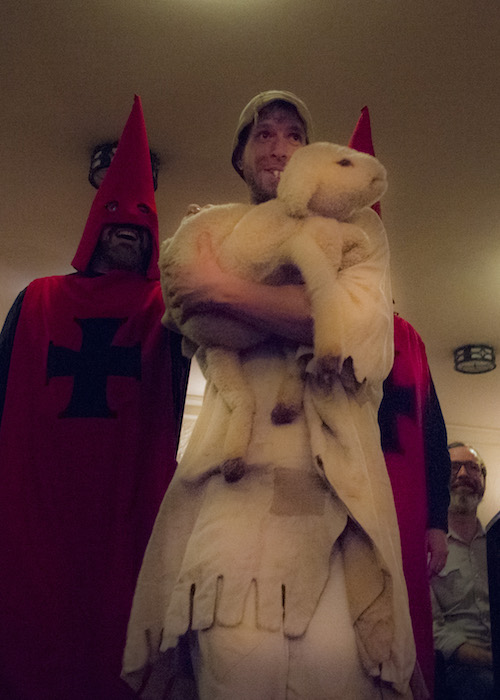
That was where I drew the line. I slunk back, suddenly wishing I hadn’t sat in the front. “I’m not family,” I was ready to say. My aunt had a look of horror on her face, and I was sorry that I dragged her into this.
Lucky for us, there were plenty of volunteers. Dozens, actually. The same audience members who were hesitant to sit in the front at the beginning of the ceremony were jumping from their seats and rushing to the front of the church.
While Mitler, the minister, organized the participating audience into a chain of two rows of people, facing each other, their forearms interlocked, two henchmen entered from either side of the church. They were both wearing giant red cone hats and red masks. They were big. And even I wanted to ask: what the hell is going on here?
Megan climbed atop the shoulders of one, Troy of another, and Ugo, Troy’s Fool, was below, still clutching the leg of Troy’s pants.
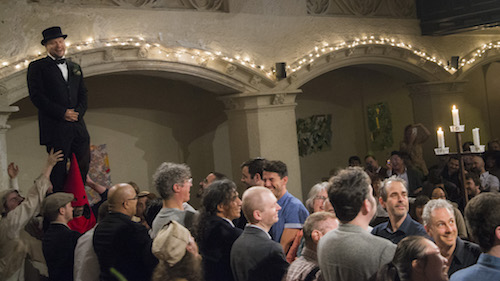
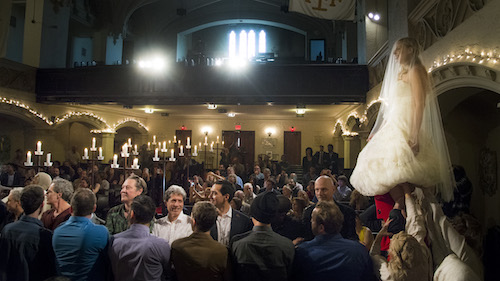
Lofted above the audience, Megan screamed the vows that she’d written weeks before, to which her minister kept saying, make them shorter, make them shorter, simpler. He didn’t tell her that it was because she’d be delivering them from atop the shoulders of a henchman.
“I, Megan Bones, take you, Troy Hahn, as my friend and lover…”
Troy too, recited his, by now his henchman was shaking and the audience and Fools placed stabilizing hands on his sides. “Beside me and apart from me, in laughter and in tears, to be truthful and loyal, patient…”
Megan was crying, and she managed her vows between tears, “In sickness, comforting in sorrow, to grow, to change, to leap into the unknown together with faith and joy.”
At that, the bride and groom leapt from the shoulders of their henchman into the arms of the crowd, sacrificing themselves, and well, a tiny shred of decency as Megan’s dress slipped. She was completely unphased. As the audience—a crowd of loved ones, family, and strangers—stared on as witnesses to this strange but profound leap into their marriage together, suddenly the questions of why? or what? dissipated.
With a “Huh! Huh! Huh!” the crowd bounced their arms up and down, lifting Megan and Troy up and across the chain of people, toward each other. It was a display of community, support, love and excitement—it was weird; it was delightful.
Lying across the arms of the audience, Megan and Troy exchanged rings. “With this ring, I thee wed, and pledge with all my soul, with all my heart, and with all my might, to love, cherish, and honor you from this day forth and forever more.”
They might be the first people to say they exchanged their rings in a Manhattan church lifted from the floor, lying down, surrounded by a bunch of Fools.
“Troy and Megan, by the power invested in me by… Father Jerzy… and the State of New York, I pronounce you man and wife. You may now kiss the bride!” Fools rushed Megan, everyone tried to grab a kiss. Claudine kissed Troy. When the frenzy quelled, the laughter subsided, Troy and Megan kissed.
All gathered around the newlyweds and sang the Bach Chorale, Gloria Sei.
The song ended. Silence. Tears covered the faces of many of the guests, including my own. Koldo shoved Troy aside and gave Megan one last big sloppy kiss. Yvonne Brecht, the older Fool with the handy book, hit him over the head again. “No!” she screamed, “No.” He tumbled.


